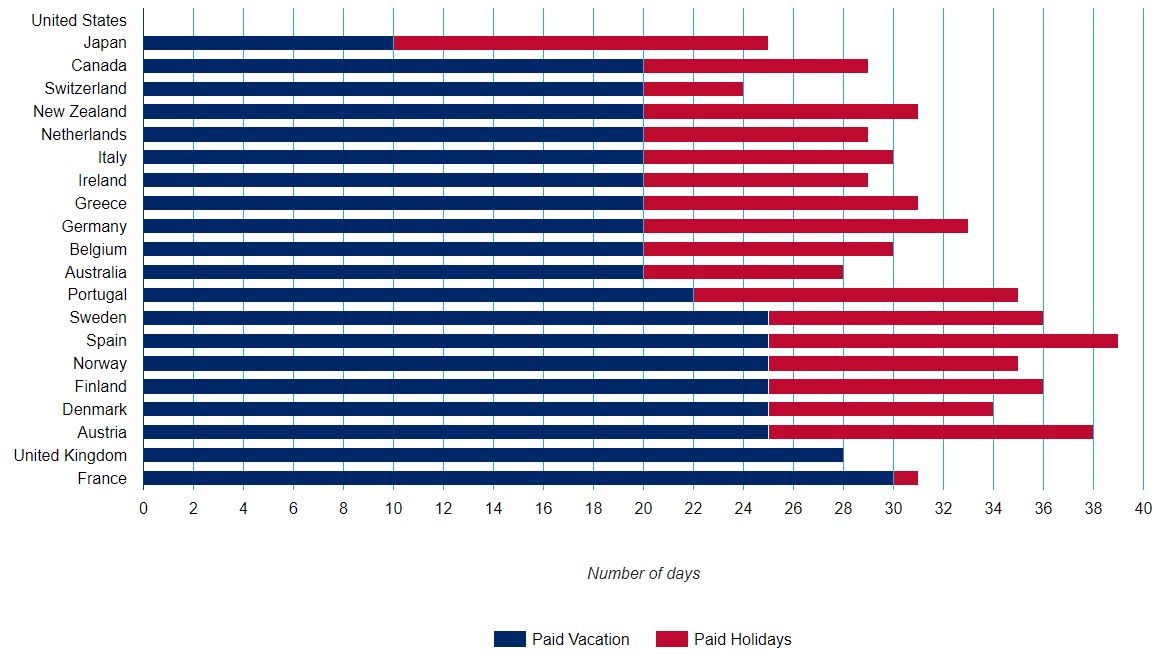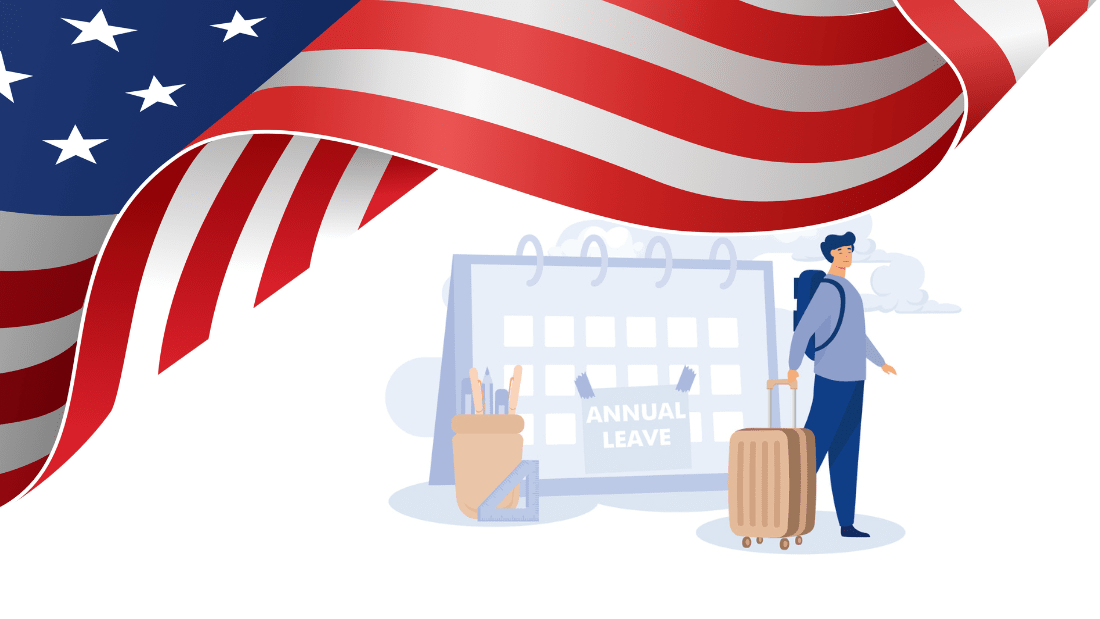Back in 1910, President William Howard Taft proposed that American workers should have three months of paid vacation every year to give them a chance to rest so they could continue their work the following year. Well, obviously that proposal didn’t come to fruition – nice as it might have been for employees.
Paid time off however had been catching on in countries outside the United States. The Treaty of Versailles, which ended World War I in 1919, called for nations to regulate the working time and rest periods. However, in the United States employers vehemently fought against interference from the government in their business affairs.
Over 120 years later and all proposed national laws mandating American businesses to give employees paid leave have been unsuccessful. The Fair Labor Standards Act (FLSA) does not require payment for time not worked, such as vacations, sick leave, or federal or other holidays. Instead, these benefits are matters of agreement between an employer and an employee (or the employee’s representative).
How does the United States compare with other developed countries?
According to the Center for Economic and Policy Research, the United States is the only country without a paid annual leave policy. In their report No-Vacation Nation no city or state in the United States guarantees paid annual leave except for the U.S. territory, Puerto Rico.
Compare this to the European Union’s Working Time Directive that guarantees European workers at least 20 paid vacation days per year, with some countries mandating as many as 25 to 30 days per year. Australia and New Zealand require employers to grant workers a minimum of 20 paid vacation days per year, while Canada and Japan require their employers to provide at least 10 paid vacation days.
The growing disparity between the United States and the rest of the world is even more pronounced when taking into account legally mandated paid holidays. Most developed countries offer a number of paid holidays a year as well as paid vacation, while the United States provides none. Spain leads the table, offering 14 paid holiday days with Austria, Germany, and Portugal hot on their heels with 13 paid holiday days.
Chart: Paid Vacation and Paid Holidays, OECD Nations, in Working Days

Data Source: No-Vacation Nation, by Adewale Maye, May 2019
Employers’ approach to paid vacation
While American workers are not legally entitled to any paid holidays, in reality, most U.S. employers do offer some paid vacation time. The number of days obviously varies from business to business but on average workers will get about ten days of paid holiday each year.
According to the US Bureau of Labor Statistics, after one year of employment, private industry workers received the following amount of annual paid vacation days:
In our earlier table, we can see that, except for Canada, all countries received at least 24 days of paid leave when you add vacation and holiday leave – only 2% of workers in the United States receive this amount after one year of service.
About one in four workers in the United States don’t get any paid vacation time or holidays at all. This particularly affects lower-income workers, part-time employees, and small business workers who can least afford to be without paid vacation.
Workers are not using their vacation days
I was really surprised to discover that many American workers don’t use up their vacation days if they are lucky enough to have them. According to research from the U.S. Travel Association, Oxford Economics, and Ipsos, even when they have vacation days they don’t use up all their days.
In 2018 and bearing in mind that was pre covid so travel was allowed, American workers left a record number of vacation days on the table. They left 768 million days, up 9% from 2017. Of the unused days, 236 million were forfeited completely, equating to $65.5 billion in lost benefits. More than half (55%) of workers reported they did not use all their allotted time off. They cited reasons such as cost, difficulty in getting away from work, and air travel hassles as being top barriers to travel.
768 MILLION
total unused vacation days
236 MILLION
days completely forfeited
$ 65.5 BILLION
in lost benefits
How can long working hours damage your health?
According to the World Health Organization (WHO) and the International Labour Organization (ILO), long working hours are increasing deaths from heart disease and stroke. Long working hours led to 745,000 deaths from stroke and ischemic heart disease in 2016, a 29% increase since 2000.
According to their global analysis, they estimate that in 2016, 398,000 people died from a stroke and 347,000 from heart disease as a result of having worked at least 55 hours a week. Between 2000 and 2016, the number of deaths from heart disease due to working long hours increased by 42%, and from stroke by 19%. The study, also showed almost three-quarters of those that died as a result of working long hours were middle-aged or older men.
There are numerous studies that demonstrate the importance of taking time out from work to recharge the batteries. Employees who don’t take time to recharge risk exhaustion, burnout, lower job performance, stress, anxiety, and generally poor health. On the flip side, employees who take a vacation are happier, better performers, and less likely to suffer from poor health.
Conclusion
We know that the pandemic had a huge effect on how, when, and where we work and it is looking like taking a vacation is finally becoming a higher priority for American workers who are sometimes referred to as workaholics. According to Allianz Partners USA’s 14th Annual Vacation Confidence Index, now more than ever, Americans are claiming their vacation days and making time to travel a priority. The survey revealed that 57% of Americans took a vacation in 2022. Up from 44% in 2021. 2022 marks the highest percentage of Americans who reported travelling since 2009 when the survey was first conducted.
Taking a vacation is essential to an employee’s health and well-being. Time off from work is integral to good mental and physical health, sustained productivity, and high performance. While it is unlikely any of us will ever get the three months off paid leave that President William Howard Taft proposed, I think we will see more American workers demanding more time off whether that is from negotiating contracts with employers or lobbying government representatives. Interesting times lie ahead.
Request a free Demo!
Take the first step towards a complete workforce management solution. Talk to us today!
About Tomislav Rucevic
Tomislav Rucevic, an SEO Specialist at Softworks, stands out as more than just a marketer. He’s a fervent writer and influential thinker passionate about Workforce Management, HR, and work-life dynamics. Holding an MBA in Marketing, Tomislav excels in creating content that delves into the complexities of the modern workplace.
His dedication to writing on these topics is highlighted in his MBA thesis, which examined the link between Employee Motivation and Quality Improvement. At Softworks, he expertly merges his SEO skills with his writing prowess, contributing to the company’s digital success and advancing discussions on enhancing work environments and achieving work-life balance.








